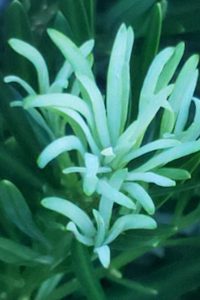
While many landscape plants can be considered “pest-free”, on occasion there are insects that pop up which are problematic or at least need some attention. Knowing about an insect pest, its overall impact to a plant, and how to manage it effectively can really make the difference in suppression. Take aphids found on Podocarpus for instance. Tiny and purple, these insect pests have sucking piercing mouthparts which can cause visible damage that sticks out like a sore thumb!
Podocarpus are generally hardy plants with few pest problems, but certain aphids can be found infesting this woody ornamental wherever it is grown. I have one Podocarpus that has a small but increasing problem with one of two aphid species known to favor Podocarpus– most likely the one called Neophyllaphis varicolor. The first thing that I noticed was a large amount of new, pale green, distorted growth. While I expected new growth to be light green in color, the stark smaller-than-normal foliage was really apparent. This aphid population was building up to a degree that their feeding behavior – using sucking-piercing mouthparts – was draining the life out of the new growth tips. Almost every new tip was stunted and small and the aphid adults and smaller nymphs were abundant.
Once identified, what are you options to control aphids on Podocarpus? The first level of control is the easiest – do nothing! Small populations can be managed by natural predators and parasites. I saw a number of lady beetles’ larvae already on patrol devouring the aphids like hungry lions. Natural predators are a tool to help suppress pests to a level that we can live with. Now, if the aphids on your Podocarpus are creating more damage than you can bear as far as visible esthetic injury, then you could step in with some least-toxic options. Commercially available insecticidal soap in a ready-to-use spray bottle applied as per label directions is a helpful option to spot treat infestations. This is a contact insecticide but works well to snuff out small populations before they spread. Horticultural oil is another least-toxic option that can also be used to suffocate the aphids. Do not apply either of these products in the heat of the day as they can burn the leaves – apply late when the temperatures have cooled. The pesticide label is the law – always read the label.
Dealing with insect pests such as aphids found on Podocarpus is classic Integrated Pest Management or IPM. The first step is positive identification followed by monitoring to access the number of pests and damage. Once a threshold level is determined which would trigger some type of action – say that you set the limit at five aphids per leaf blade – then we try the use of several tools including mechanical removal and/or least-toxic pesticides to lower the pest population. While we can never fully eradicate some pests, we can suppress them to a level we can live with – that is the goal!
Aphids including those found on Podocarpus are a fact of life here in Florida. Regular monitoring of your landscape plants will help you detect problems while they are small and manageable – common sense rules! For more information on all types of insect pests common to our landscapes, or to ask a question, you can also call the Master Gardener Volunteer Helpdesk on Mondays, Wednesdays, and Fridays from 1 to 4 pm at 764-4340 for gardening help and insight into their role as an Extension volunteer. Ralph E. Mitchell is the Director/Horticulture Agent for UF/IFAS Extension – Charlotte County. He can be reached at 941-764-4344 or ralph.mitchell@charlottecountyfl.gov, Connect with us on social media. Like us on Facebook @CharlotteCountyExtension and follow us on Instagram @ifascharco.
Resources:
Eleanor F. Phillips and Jennifer L. Gillett-Kaufman (2017) Podocarpus Aphid (suggested common name) Neophyllaphis podocarpi Takahashi (Insecta: Hemiptera: Aphididae). The University of Florida Extension Service, IFAS.
Brown, S. H. & Mannion C., (2014) Aphids (Neophyllaphis podocarpi and N. varicolor) on Podocarpus macrophyllus. The University of Florida Extension Service, IFAS – Lee County.
Source: UF/IFAS Pest Alert
Note: All images and contents are the property of UF/IFAS.



